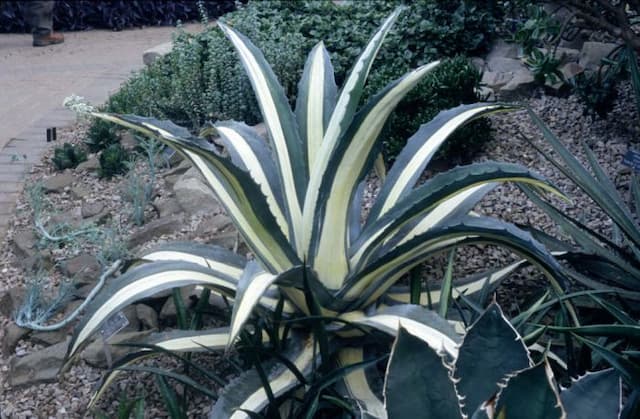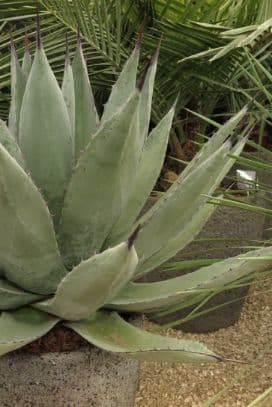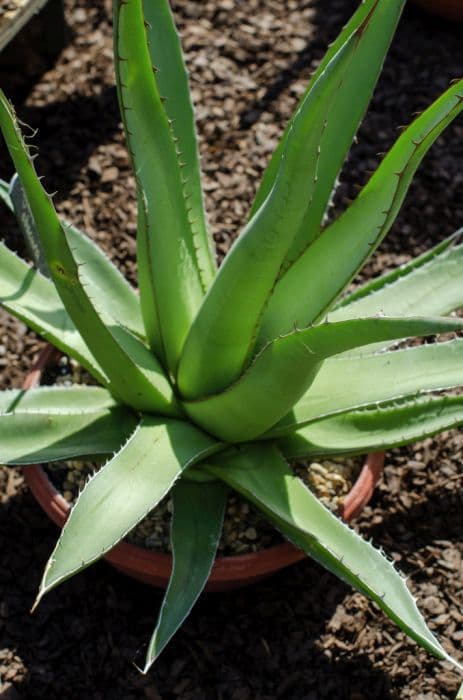Cape cowslip Lachenalia vanzyliae

ABOUT
The Lachenalia vanzyliae, commonly known as Van Zyl's Lachenalia, is a visually striking plant known for its distinctive coloration and pattern. The plant typically produces a rosette of leaves that are a deep green hue, sometimes with spotted or mottled patterns of a lighter green, adding contrast and visual interest. As a bulbous plant, it forms its leaves from an underground bulb which stores energy, allowing the plant to survive dormant periods. When in bloom, Van Zyl's Lachenalia sprouts stalks that carry a series of flowers. These flowers are particularly notable for their vibrant colors ranging from purples and pinks to oranges and yellows, often with intricate markings that may include speckles, stripes, or other variations. The flowers are usually tubular or bell-shaped, arranged in a raceme, which means they form along the flowering stalk in a cluster. Each individual flower has a unique charm, adding to the overall allure of the plant. Overall, Van Zyl's Lachenalia is appreciated for its ornamental beauty and the splash of color it brings when flowering, making it a celebrated choice among plant enthusiasts who appreciate its aesthetic qualities.
About this plant
 Names
NamesFamily
Asparagaceae
Synonyms
Van Zyl's Lachenalia
Common names
Lachenalia vanzyliae
 Toxicity
ToxicityTo humans
There is limited specific information available regarding the toxicity of Lachenalia vanzyliae, commonly known as Lachenalia, to humans. However, it is known that some species within the Lachenalia genus contain compounds that can be toxic if ingested. If a person ingests parts of a Lachenalia plant, they might experience gastrointestinal symptoms such as nausea, vomiting, and diarrhea. As with any suspected plant poisoning, prompt medical attention is recommended.
To pets
Lachenalia vanzyliae, commonly referred to as Lachenalia, may contain alkaloids or other toxic compounds that can be harmful to pets if ingested. While specific toxicity information about this particular species might be limited, ingestion could potentially lead to symptoms similar to those seen in humans, such as gastrointestinal upset, including vomiting and diarrhea. Pets might also exhibit signs of lethargy or drooling. If you suspect your pet has ingested any part of a Lachenalia plant, it is important to contact your veterinarian or an animal poison control center immediately.
 Characteristics
CharacteristicsLife cycle
Perennials
Foliage type
Deciduous
Color of leaves
Varies
Flower color
Mixed
Height
0.5 feet (15 cm)
Spread
0.5 feet (15 cm)
Plant type
Bulb
Hardiness zones
8
Native area
South Africa
Benefits
 General Benefits
General Benefits- Aesthetic Appeal: Lachenalia vanzyliae, also known as Cape cowslip, provides vibrant color and unique shapes to any garden or floral arrangement.
- Ease of Care: Cape cowslip is known for being low-maintenance, requiring minimal watering and fertilization.
- Drought Tolerance: This plant is adapted to survive in dry conditions, making it ideal for water-conscious gardeners or regions with water restrictions.
- Seasonal Interest: Cape cowslip flowers during late winter to spring, offering a splash of color when most other plants are not in bloom.
- Attracts Wildlife: The flowers of the Cape cowslip can attract pollinators such as bees and butterflies, enhancing biodiversity in the garden.
- Compact Size: The plant's small size makes it suitable for container gardening or small spaces.
- Bulb Propagation: It can be easily propagated through its bulbs, providing gardeners with a sustainable way to increase their collection.
 Medical Properties
Medical PropertiesThis plant is not used for medical purposes.
 Air-purifying Qualities
Air-purifying QualitiesThis plant is not specifically known for air purifying qualities.
 Other Uses
Other Uses- Lachenalia vanzyliae bulbs can be crushed and used as an adhesive in homemade crafts due to their sticky juice after being crushed.
- The flowers of Lachenalia vanzyliae can be used as a natural dye, providing a subtle color for fabric and yarn when boiled and strained.
- Dry leaves of the plant can be used to create eco-friendly packaging material as an alternative to plastic bubble wrap.
- The plant's sturdy leaves can be woven into small decorative baskets or mats by hobbyists who enjoy plant-based crafts.
- Fresh or dried Lachenalia vanzyliae flowers can be incorporated into potpourri mixtures for a sweet and pleasant aroma.
- Seed pods from Lachenalia vanzyliae can be used as natural beads in jewelry making after they are dried and drilled.
- The plant can serve as an educational tool for botany students studying bulbous plant structures and growth cycles.
- Lachenalia vanzyliae can be utilized in themed gardens to represent the biodiversity of South Africa, where the plant is natively found.
- The plant's unique appearance can be used in photography and still life art as a focal point due to its distinctive flowers.
- Leaves of Lachenalia vanzyliae can be employed as bookmarks, offering an organic touch to readers who appreciate nature-inspired accessories.
Interesting Facts
 Feng Shui
Feng ShuiThe Lachenalia is not used in Feng Shui practice.
 Zodiac Sign Compitability
Zodiac Sign CompitabilityThe Lachenalia is not used in astrology practice.
 Plant Symbolism
Plant Symbolism- Rarity: Given its relatively obscure status and unique appearance, Lachenalia vanzyliae, commonly known as Van Zyl's Lachenalia, can symbolize uniqueness or rarity in the plant world, celebrating the beauty of less common flora.
- Resilience: As a plant that grows in rocky areas and adapts to its environment, Van Zyl's Lachenalia represents resilience, the ability to thrive in challenging conditions, and adaptability in life.
- Beauty: With its delicate and colorful flowers, Van Zyl's Lachenalia is often associated with beauty and the appreciation of aesthetic qualities.
- New Beginnings: As a bulbous plant, it may represent new beginnings or rebirth, symbolizing the potential for new growth and renewal since bulbs often signify the start of the flowering season.
 Water
WaterThe Cape Cowslip should be watered moderately during its active growth phase, which is typically from late fall to early spring. Water the plant when the top inch of soil feels dry to the touch, using about 8-16 ounces of water, depending on pot size, ensuring even moisture throughout the soil. During its dormant period, after the leaves have died back, reduce watering to a minimum, just enough to prevent the soil from drying out completely. It's important to avoid overwatering, as this can lead to bulb rot.
 Light
LightThe Cape Cowslip prefers bright, indirect light to flourish. Place it in a spot where it receives plenty of light but is shielded from the harsh midday sun. An east or west-facing window would be ideal, where it can enjoy the softer morning or late afternoon sunlight without the risk of scorching its leaves.
 Temperature
TemperatureThe ideal temperature for Cape Cowslip ranges between 60 to 70 degrees Fahrenheit during its growing season. It can survive a minimum temperature of around 50 degrees Fahrenheit but should be protected from frost. During its dormant period in summer, the plant can tolerate slightly higher temperatures, but it should not be exposed to extremes outside of the 50 to 70 degrees Fahrenheit range.
 Pruning
PruningPruning the Cape Cowslip is generally not needed except for the removal of spent flower stalks and yellowing leaves to maintain a tidy appearance. The best time to remove the spent blossoms is immediately after they fade. Regularly deadheading will encourage more blooms and prevent the plant from putting energy into seed production.
 Cleaning
CleaningAs needed
 Soil
SoilCape Cowslip prefers a well-draining potting mix with some sand or perlite to enhance drainage. The ideal pH for Cape Cowslip should be slightly acidic to neutral, ranging from 6.0 to 7.0. A mix of two parts loam, one part peat, and one part sand can provide a good balance of nutrients and drainage.
 Repotting
RepottingCape Cowslip should be repotted every two to three years or when it outgrows its current container. This will provide fresh soil and allow room for the bulb to grow. Care should be taken to not damage the bulb during repotting.
 Humidity & Misting
Humidity & MistingCape Cowslip thrives in moderate humidity levels, ideally between 40% to 60%. It’s crucial to avoid overly humid conditions to prevent rot and fungal diseases.
 Suitable locations
Suitable locationsIndoor
Grow Cape Cowslip in bright light, cool temps, and on well-draining soil.
Outdoor
Plant Cape Cowslip in partial shade, well-draining soil, and protect from frost.
Hardiness zone
8-10 USDA
 Life cycle
Life cycleLachenalia vanzyliae, commonly known as van Zyl's lachenalia, begins its life cycle when the underground bulb, lying dormant during the dry season, responds to cooler, moist conditions, typically in autumn, by initiating growth. As the environment becomes conducive, leaves emerge, often mottled with attractive patterns, marking the vegetative stage. Following leaf development, a flower spike will arise, producing colorful blooms that are the reproductive phase, during which pollination occurs, likely assisted by insects. After flowering, seeds are produced and dispersed, potentially giving rise to new bulbs in suitable conditions. As the season progresses towards summer, the plant's above-ground foliage dies back, and the bulb enters a dormant period, conserving energy for the next growth cycle. This pattern of seasonal growth and dormancy repeats annually, contributing to the plant's long-term survival in its native habitat.
 Propogation
PropogationPropogation time
Spring
Propogation: Lachenalia vanzyliae, commonly known as van Zyl's lachenalia, is typically propagated through bulb division, which is the most popular method. The best time for this process is after the foliage has died back and the plant has entered dormancy, usually in late spring or early summer. To propagate, carefully unearth the bulbs and detach any offsets from the main bulb. These offsets are mini bulbs that have formed at the base of the parent bulb. Each offset should have some roots attached. Replant these offsets in well-draining soil at a depth of about 2 inches (5 cm) and space them 3 to 4 inches (7.5-10 cm) apart. Water the newly planted offsets sparingly until new growth appears, indicating that they have established themselves and begun to grow.









